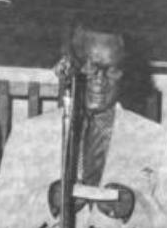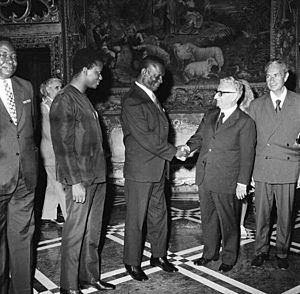Siaka Stevens facts for kids
Quick facts for kids
Siaka Probyn Stevens
|
|
|---|---|

President Stevens delivering a speech at the United States Embassy in Freetown, 1976
|
|
| 1st President of Sierra Leone | |
| In office 21 April 1971 – 28 November 1985 |
|
| Vice President | Sorie Ibrahim Koroma Christian Alusine Kamara-Taylor Francis Minah |
| Preceded by | Christopher Okoro Cole (acting) |
| Succeeded by | Joseph Saidu Momoh |
| 3rd Prime Minister of Sierra Leone | |
| In office 26 April 1968 – 21 April 1971 |
|
| Monarch | Elizabeth II |
| Governor-General | Sir Banja Tejan-Sie Christopher Okoro Cole |
| Preceded by | Sir Albert Margai |
| Succeeded by | Sorie Koroma |
| Leader of the All People's Congress (APC) | |
| In office 1962 – 28 November 1985 |
|
| Preceded by | Position established |
| Succeeded by | Joseph Saidu Momoh |
| Mayor of Freetown | |
| In office May 1962 – 17 May 1966 |
|
| Succeeded by | Constance Cummings-John |
| Member of Parliament of Sierra Leone from Port Loko District | |
| In office May 1957 – 1958 |
|
| Member of Parliament of Sierra Leone from Western Area Urban District | |
| In office 1958–1962 |
|
| Sierra Leone Protectorate Minister of Mines, Lands and Labour | |
| In office 1951–1957 |
|
| Personal details | |
| Born |
Siaka Probyn Stevens
24 August 1905 Moyamba, British Sierra Leone |
| Died | 29 May 1988 (aged 82) Freetown, Sierra Leone |
| Political party | All People's Congress (APC) |
| Spouse | Rebecca Stevens |
| Alma mater | Fourah Bay College, Ruskin College |
| Profession | Trade unionist, police officer |
Siaka Probyn Stevens (born August 24, 1905 – died May 29, 1988) was a very important leader in Sierra Leone. He served as the country's Prime Minister from 1967 to 1971. After that, he became the first President of the Republic, serving from 1971 to 1985.
Stevens led the All People's Congress (APC) party. They won the elections in 1967, beating the party of the previous Prime Minister, Sir Albert Margai. In April 1971, Sierra Leone became a republic, which means it no longer had a king or queen. Stevens then became president. He was the second person to be president, but the first to serve a full term.
He also led the Organisation of African Unity (OAU) from 1980 to 1981. He helped create the Mano River Union, which is an economic group of three countries: Sierra Leone, Liberia, and Guinea. Stevens retired in 1985 and chose Joseph Saidu Momoh to take over. He passed away in Freetown in 1988.
Contents
Early Life and Work
Siaka Probyn Stevens was born on August 24, 1905, in Moyamba, Sierra Leone. His father was from the Limba group, and his mother was from the Mende group. Even though he was born in Moyamba, he grew up mostly in Freetown.
He went to primary school and then to Albert Academy in Freetown. After school, he joined the Sierra Leone Police Force in 1923. He worked there for seven years, becoming a First Class Sergeant.
Later, from 1931 to 1946, Stevens helped build a railway for a mining company. This railway connected the port of Pepel to the iron ore mines at Marampa. In 1943, he helped start the United Mine Workers Union. He was chosen to represent workers in the Protectorate Assembly in 1946. In 1947, he went to Ruskin College to study about how workers and employers get along.
Starting a Political Career
In 1951, Stevens helped create the Sierra Leone People's Party (SLPP). He was elected to the Legislative Council. The next year, he became Sierra Leone's first Minister of Mines, Lands, and Labor. In 1957, he was elected to the House of Representatives.
Later, Stevens disagreed with the SLPP leaders. He left the party and helped start the People's National Party (PNP). He was the first secretary-general and deputy leader of this new party.
In 1959, he went to London for talks about Sierra Leone becoming independent. But he was the only one who refused to sign the agreement. He was worried about a secret defense deal with the United Kingdom. He also wanted elections to happen before independence, which the government did not agree with. Because of this, he was removed from the PNP. Stevens then started the Elections Before Independence Movement (EBIM).
He later formed the All People's Congress (APC) party on March 20, 1960. This party was created by people who wanted elections to happen after Sierra Leone became independent.
Becoming Prime Minister
In the elections held on March 17, 1967, the APC won by a very small number of votes. Stevens became Prime Minister. However, just minutes after taking office, he was arrested during a military takeover.
After a short time of military rule, Stevens became Prime Minister again on April 26, 1968. In April 1971, Sierra Leone became a republic. This meant it would have a president instead of being led by a monarch. Chief Justice Christopher Okoro Cole was president for two days. Then, Stevens became president with a lot of power.
Leading Sierra Leone as President
In 1973, the first elections under the new republic were held. There was some violence, and the SLPP party decided not to take part. This meant Stevens's APC party won all 85 seats in the House of Representatives. In 1976, Stevens was re-elected president without anyone running against him.
During the 1970s, Stevens gained more and more power. In 1978, a new constitution was voted on. This constitution made Sierra Leone a one-party state. This meant the APC was the only legal political party. Stevens said this system was more "African." The vote showed that almost everyone supported the new constitution, but many people believed the results were not fair.
After this, all members of the House of Representatives who were not part of the APC had to join the party or lose their seats. Stevens was re-elected for a five-year term, and then for another seven-year term. People started calling him "Dr. Stevens" and "Pa Shaki."
President Stevens was the leader of the Organisation of African Unity (OAU) from July 1, 1980, to June 24, 1981. He also helped create the Mano River Union. This group helps Sierra Leone, Liberia, and Guinea work together on economic issues. For a short time, he was also the Minister of Finance.
During his time as president, Stevens's government faced challenges. The country's money was not managed well. Basic services like education became very difficult to access. This caused a lot of poverty, especially in rural areas. Many people who disagreed with him were put in prison. These problems contributed to the Sierra Leone Civil War that started after he retired.
Sierra Leone's Global Connections
Siaka Stevens made connections with countries like North Korea, Cuba, and China. At first, some Western leaders were cautious about this. However, he also had a strong connection to Britain. He believed that "old friends were the best."
He supported Britain on many global issues, like the dispute over Gibraltar. He said Spain had no right to Gibraltar. He also liked many things Sierra Leone got from Britain, such as sports like football and cricket, and the legal system. He was proud of going to Ruskin College in Britain. His middle name, "Probyn," came from a British governor named Leslie Probyn.
Stevens said that even though he became an African nationalist because of unfairness during colonial times, he did not blame the British people he knew. He felt they were part of a system from history.
Retirement and Legacy
Stevens retired from being president on November 28, 1985. He chose Joseph Saidu Momoh to be the next president. Stevens passed away in Freetown on May 29, 1988.
Because of some of the challenges during Stevens's time, Sierra Leone's current constitution limits how long a president can serve. A president can only serve two five-year terms.
Images for kids
See also
 In Spanish: Siaka Stevens para niños
In Spanish: Siaka Stevens para niños




